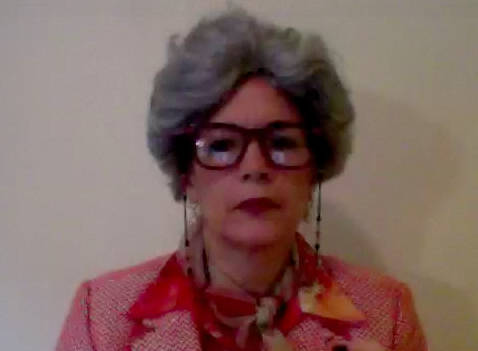Category: Business Strategies
Posted by Dr. El - March 4, 2015 - Bullying/Senior bullying, Business Strategies, McKnight's Long-Term Care News, Resident education/Support groups

Here’s my latest article on McKnight’s Long-Term Care News:

Things were different when I was a kid. People regularly drove while intoxicated. The high school archery team practiced on the football field while the track team ran around the periphery. Children bullied their peers without anyone giving it much notice.
These days, drunk driving prohibitions abound, schools are no longer casual about teens with potential weapons, and children start learning about bullies in kindergarten.
When it comes to bullying in senior communities, though, we’re still behind the times.
What is senior bullying?
According to the American Psychological Association, “Bullying is a form of aggressive behavior in which someone intentionally and repeatedly causes another person injury or discomfort. Bullying can take the form of physical contact, words or more subtle actions.
The bullied individual typically has trouble defending him or herself and does nothing to ‘cause’ the bullying.” Bullying that does not involve physical contact is sometimes referred to as “relational aggression.”
According to senior bullying expert Dr. Robin Bonifas at Arizona State University, 10% to 20% of elders in senior communities experience bullying.
Dr. Margaret Wylde of the ProMatura Group reports that senior bullying occurs in every independent living community studied in her 2014 report, “Make Them Feel at Home,” sponsored by the American Seniors Housing Association.
In that study, bullying fell into the category with the largest relationship to whether or not the community feels homelike. Study participants described problems such as “difficulties making friends, being lonely, not fitting in, not having common interests, bullying by cliques, and missing their friends.”
Wylde notes that increasing residents’ sense of being at home results in fewer departures from the independent living community and reduced staff turnover, leading to an estimated $52,242 in savings over the course of a year. (Far more than enough to fund a bullying prevention program!)
Increased media focus
Senior bullying is receiving increased attention in the mainstream media, with articles such as Paula Span’s New Old Age column, Mean Girls in Assisted Living and Jennifer Wiener’s Mean Girls in the Retirement Home. (“Mean girls” tend to engage in gossip, excluding others and establishing cliques, while male bullies are more likely to yell and threaten.)
Heightened media exposure for the issue increases the likelihood that potential residents and their adult children will be asking about bullying prevention when they’re searching for a senior living community.
Steps to reduce bullying
In order to address bullying in long-term care, several steps should be taken:
For the entire article, visit:

Posted by Dr. El - February 18, 2015 - Business Strategies, Communication, End of life, McKnight's Long-Term Care News, Talks/Radio shows

Here’s my latest article on McKnight’s Long-Term Care News:

Last week, I attended the MarcusEvans LTC and Senior Living CXO Summit in Los Angeles, where I delivered a keynote address on “Identifying and Repairing Communication Gaps in LTC.” It was a fascinating, energizing event, and not just because I was leaving the frigid temperatures of New York City to dine outdoors in Marina Del Rey.
Of course, I was all jazzed up to speak about my obsession, long-term care. Of the many communication gaps I mentioned that need repairing, the one that most people commented on afterward was the way we handle end-of-life care.
Perhaps the ample feedback reflected how we, as a country, are spending so much money on aggressive medical treatments that are unlikely to help those who are dying and that most people wouldn’t want if they knew what they entailed. Or perhaps it’s because the vast majority of the audience was not only professionals in the field but also had a relative in long-term care. They recognized the value of having a peaceful death both for the resident and for their family.
It was interesting to me that only a few of these C-suite attendees had heard of Atul Gawande, MD, whose recent book on end-of-life care, “Being Mortal: Medicine and What Matters in the End,” became the basis for a “Frontline” documentary that aired last week. Atul Gawande is all the rage in my circle.
I, on the other hand, was gobbling up new information about positioning care facilities to thrive over the long haul. The clinical and the financial sides of the business have a lot to teach each other.
One of the highlights for me was hearing Dr. Margaret Wylde of the ProMatura Group speak about what’s important to residents of senior living communities. I was so excited by her information that I leaped from my seat and shouted, “Yes! Yes! Right on, sister!” At least, that’s what I was doing on the inside, while my outside sat politely nodding in my gray business suit.
For the entire article, visit:

Posted by Dr. El - February 5, 2015 - Business Strategies, Communication, McKnight's Long-Term Care News

Here’s my latest article on McKnight’s Long-Term Care News:

In the TV show “Mad Men,” the Sterling Cooper advertising executives find out how consumers feel about the product they’re pitching by holding focus groups. They ask people who use their product what they like and don’t like about it, how they use it and what it means to them.
As a long-term care psychologist, one of my main tasks is to sit down and talk in-depth with residents on a regular basis. I’ve basically conducted 20 years of focus groups. The single most common comment I’ve heard from residents over the years: “I never thought I would end up in a place like this.”
While it’s probably not the case for people who entered swanky continuing care retirement communities of their own accord well in advance of a health crisis, many residents feel like it’s a personal failure to be in long-term care. They think if they’d done something different, or earned more money, or if they’d had children, or had a better relationship with their children, or if they had better children, or something, then they wouldn’t have “ended up” in a long-term care home.
As a psychologist, I assure them that they didn’t do anything wrong and neither did anyone else necessarily. I inform them that many of the nicest and best people I know are living in long-term care. Occasionally, I introduce one awesome person to another. In psychology terms, we call this “normalizing” the experience. It helps a lot.
Below are some ways in which you can allay the residents’ concerns that they have lost the game of life by being in your establishment:
• Include on your website stories of amazing residents. If that exemplary person can be there, potential residents will feel that it’s a club they might want to join too. Include not just individuals who have achieved a traditionally successful life (money, fame, education), but also those who have accomplished unusual feats (raised 11 children, sky-dived in their 70s) or who overcame poverty, prejudice, or disability to lead a good and decent life.
For the entire article, visit:

Posted by Dr. El - January 6, 2015 - Business Strategies, Common Nursing Home Problems and How Psychologists Can Solve Them, McKnight's Long-Term Care News, Motivating staff, Psychology Research Translated

Here’s my latest article on McKnight’s Long-Term Care News:

Standing by the salad bar in the newly opened restaurant, I recoiled at the sign that read, “Please don’t use your hands.” I suggested to the manager that the notice should instead advise diners to “Please use the serving spoons.” My recommendation for that short-lived establishment followed what’s known as “nudge principles.”
What are nudge principles?
Nudge principles use basic human tendencies to encourage people to engage in positive behavior. One aspect of nudge is to craft messages, like how to use the salad bar, in ways that are more likely to result in positive action.
Another aspect, according to Tori DeAngelis in Coaxing Better Behavior, is to harness “our less laudatory traits — short-sightedness, inertia, inflated optimism and our tendency to submit to peer pressure.”
Research shows people have a “default bias” which makes them more likely to choose the first option in front of them. Putting fresh fruit before the desserts in a cafeteria line would be one way of making positive use of this bias. Another is creating a default option that enrolls employees in a retirement account rather than requiring them to opt into the program.
Care must be taken to create good default options, though, or they can backfire. One poorly constructed automatic retirement account enrollment, for instance, resulted in more individuals contributing, but fewer dollars set aside overall. Why? The default choice set aside less money than what people might have chosen if they’d given it more thought.
Starting with the end result
Some “nudge” researchers identify the outcome they want to see and then look at what methods are most successful in achieving that outcome. In one study, the British government sent letters to delinquent taxpayers, saying, for example, “You are one of the few who have not paid us yet.” They altered the wording of the letters to see which phrasing would result in the greatest collection of outstanding funds — and retrieved an extra $15 million overall.
Applying nudge principles in LTC
For the entire article, visit:

Posted by Dr. El - December 11, 2014 - Business Strategies, Customer service, Engaging with families, McKnight's Long-Term Care News

Here’s my latest article on McKnight’s Long-Term Care News:

Jane Gross’ recent post Seeing the ‘Invisible Patient’ in the “New Old Age” blog of the New York Times discusses how professionals often ignore the needs of caregivers of the elderly because they are focused on their identified patient. As the author states, “Not once in the years I cared for my mother did any of her physicians ask me how I was doing.”
While the article centers on the burdens of caregivers in the community, it got me thinking about whether we’re meeting the needs of families whose loved ones are in long-term care.
What are the burdens of family members in LTC?
Some families have been down a long road of illness with their loved one and are physically and emotionally depleted. Others have had the shock of a sudden shift in the condition of their relative and have been swiftly thrust into the world of LTC. Virtually all of the families are coming into a system that’s new for them and they could use our help in successfully navigating this change.
Benefits to the facility
Addressing the needs of family members can:
• Increase the likelihood of families making positive contributions to the lives of the residents, which is good for the residents and reduces the workload of the staff. If families are purchasing clothes, for example, that’s one less task for staff members.
• Improve satisfaction with our services and increase the chances that they’ll recommend our facility to others.
• Provide a benefit that appeals to the adult children decision-makers and makes our organization more competitive.
Below are some ways to creatively and inexpensively attend to the needs of families:
For the entire article, visit:

Posted by Dr. El - December 8, 2014 - Business Strategies, Customer service, Talks/Radio shows

Join Dr. El
Wednesday, December 10th
at 2pm Eastern Time (1pm Central Time)
for a
FREE Webinar on
Secrets to Creating an Emotionally Healthy Environment for Residents
sponsored by EmLogis
To register:
About the Webinar:
Is lack of attention to residents’ emotional health undermining your efforts to provide good medical care? Join psychologist Dr. Eleanor Feldman Barbera as she discusses how to create an emotionally healthy environment that enhances medical services and improves the experience of residents, families and staff.
What you will learn:
Symptoms of an emotionally unhealthy atmosphere
Elements that contribute to a healthy environment
Realistic, feasible steps toward creating an emotionally healing atmosphere
Who should attend this webinar:
Administrators and assistant administrators
DONs, ADONs, department heads, and nursing supervisors
Staff training coordinators
All direct care staff

Posted by Dr. El - November 14, 2014 - Business Strategies, Communication, McKnight's Long-Term Care News

Here’s my latest article on McKnight’s Long-Term Care News:

Poor communication and coordination between staff members contribute to medication errors and adverse events. These problems are more likely to occur during a transition of care from one setting to another.
AMDA, The Society for Post-Acute and Long-Term Care Medicine, working with the National Transitions of Care Coalition (NTOCC), recently released its free Transitions in Care in the Long-Term Care Continuum guideline. The goal of the document is to identify areas where problems in transitions occur and to offer methods to avoid these common errors.
Reading through the guideline got me thinking about the in-house communication glitches I’ve noticed in my role as a psychologist. While we clearly need to address communication and coordination between settings, we also can look within our own facilities to see if there are areas where communication could be improved.
Below are examples of problems I’ve observed in some high-quality facilities. (Imagine how much better the care would be if these problems were addressed!) While I mentioned my concerns to the relevant staff members, interdepartmental communication issues can sometimes fall into that gray area between job descriptions and don’t always receive the attention they deserve.
• Each floor of one facility had a notebook where staff members could leave messages for the social worker. Except that the social workers never looked at those notebooks. New staff members would leave notes in there until they learned it was pointless. But nobody took the notebooks away.
• There are communication books for the attending physicians at most nursing stations, but the doctors vary in their diligence about looking at the information. Sometimes I’d check the log to see the status of something I’d previously reported and see that nothing had been checked off in the book for a month or even several months. While very urgent information should be reported directly to the charge nurse, many staff members don’t have the training to know what’s urgent.
• Along those lines, I once mentioned to a charge nurse that I wrote a note in the communication book and she said, “Oh, Dr. Smith never looks in there. If you have something important to tell him, you let me know and I’ll write it on a sticky note and tell him when he comes in.” She pointed to the ledge of the desk filled with scrawled memos. Things I pondered: What if the sticky note loses its “stick,” falls to the floor, and is swept up by the porter? Who else is leaving notes in the logbook without realizing they’re never seen? What if the nurse is off from work on the day the physician comes in? The nurse retired shortly thereafter. I wonder what they’re doing now.
For the entire article, visit:

Posted by Dr. El - November 7, 2014 - Aunt Sylvia, Business Strategies, Talks/Radio shows, Videos

Join Dr. El
Wednesday, November 12th
at 2pm Eastern Time (1pm Central Time)
for a
FREE Webinar on
Creating an Emotionally Healthy Workplace
sponsored by EmLogis
To register:

Aunt Sylvia Stays Psychologically Healthy: Click here or view below: http://youtu.be/NlNZVnmNpfo
About the Webinar:
Is your work environment undermining the efforts of staff members to provide high quality services to the residents and families under their care?
Join psychologist Dr. Eleanor Feldman Barbera live on November 12th at 1pm central as she discusses the positive impact of addressing the emotional health of the workplace and offers immediately implementable tools and suggestions that will foster an emotionally healthy environment.
What you will learn:
- The practical (and financial) benefits of a psychologically healthy workplace
- The five different elements that contribute to a positive environment
- Realistic, feasible steps toward making your workplace emotionally healthy
Who should attend this webinar:
- Administrators and assistant administrators
- DONs, ADONs, department heads, nursing supervisors, and charge nurses
- Staff training coordinators
- Human resource department staff
Posted by Dr. El - October 15, 2014 - Business Strategies, Customer service, Resident care, Talks/Radio shows

Tomorrow, 10/16, I’ll be a guest on “When Things Go Wrong,” the Wharton Business Radio show of professor Christian Terwiesch. The live show is 10/16 at 4pm ET and I’ll be on at 4:30pm. Professor Terwiesch will be addressing customer services issues in long-term care. They don’t provide the questions in advance so I have no idea what he’s going to ask me, but I’ll do my best to represent psychology and long-term care while acknowledging the reality of occasional lapses in customer service.
If you want to listen live (or on-demand after the show is over), see below for a link to a 30-day free trial of SiriusXM.
I hope you’ll join us for what promises to be a very interesting discussion!
Here’s the link to a 30-day free trial of SiriusXM: http://www.siriusxm.com/freetrial
The interview will air live on SiriusXM Satellite Radio Channel 111, as well as online at SiriusXM.com. It will also be available on-demand online to SiriusXM subscribers for 30 days after the live broadcast. This trial will allow any non-subscribers to listen live online at SiriusXM.com and via the SiriusXM free mobile app. Business Radio is in the Talk and Entertainment section of the site. Please feel free to pass it along to any colleagues, followers, friends, etc.
If you would like to listen back to recent shows (or the interview afterward), you can do so by following the steps below.
Once you have the trial:
• Go to SiriusXM.com and sign in
• Click ‘Listen Online’ in top right corner
• Click ‘Shows On-Demand’
• Then search for the show by name – When Things Go Wrong
• Click on recent shows to listen

Posted by Dr. El - September 29, 2014 - Aunt Sylvia, Business Strategies, Motivating staff, Talks/Radio shows

Join Dr. El
Thursday, October 2nd
at 2pm Eastern Time (1pm Central Time)
for a
FREE Webinar on
Using Psychology to Motivate Staff
sponsored by EmLogis
To register:

Aunt Sylvia Motivates the Staff: Click here or view below: http://youtu.be/byhU_OgiIaY
About the Webinar:
Create a sense of hope and momentum throughout your organization by engaging in simple practices that create tremendous change. Join psychologist Dr. Eleanor Feldman Barbera as she discusses practical techniques based on psychological principles that promise big impact in motivating your staff. Register now for this free webinar on October 2nd, 2014 at 1PM – space is limited!
What you will learn:
• How to turn energy-zapping organizational habits into systems that revitalize and invigorate your teams
• Practical, easy-to-implement ideas your staff will notice immediately
• Ways to build small changes into large and lasting impact
Who should attend this webinar:
• Administrators and assistant administrators
• DONs, ADONs, department heads, nursing supervisors, and charge nurses
• Staff training coordinators
• Human resource department staff




















